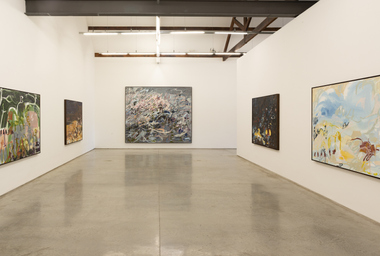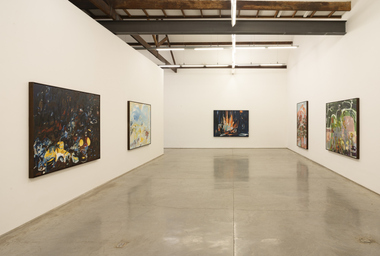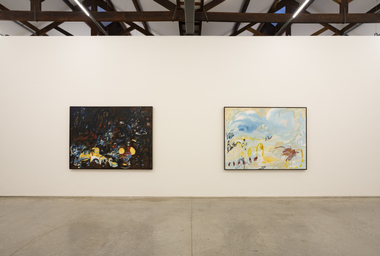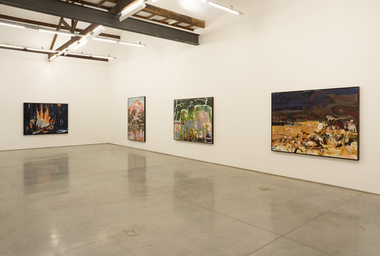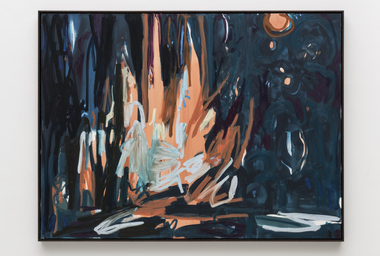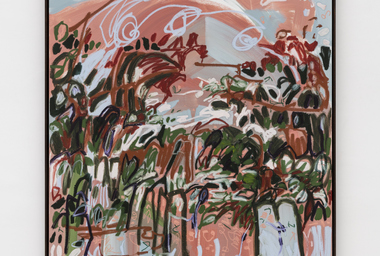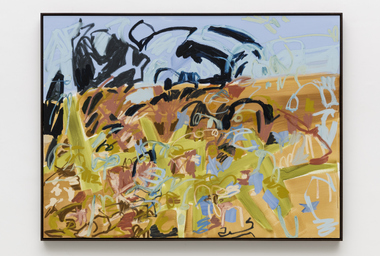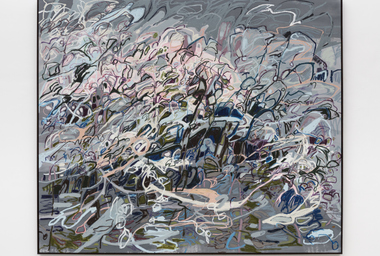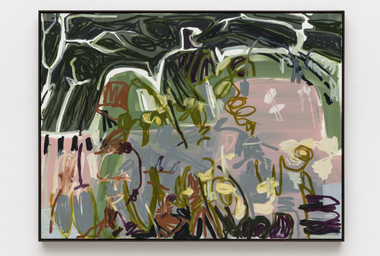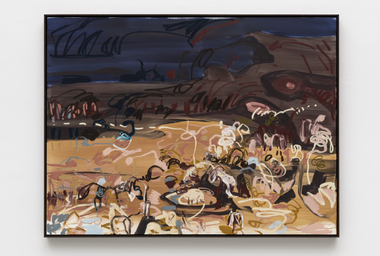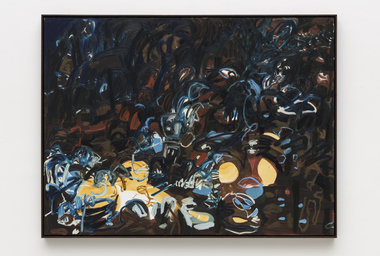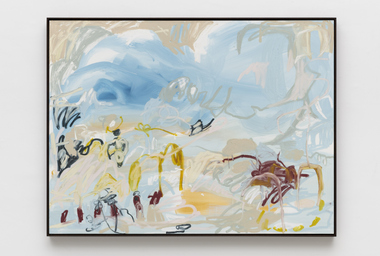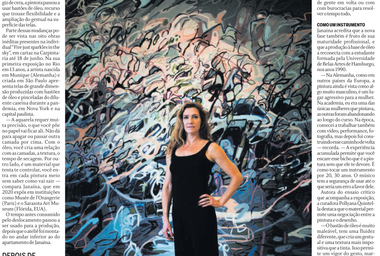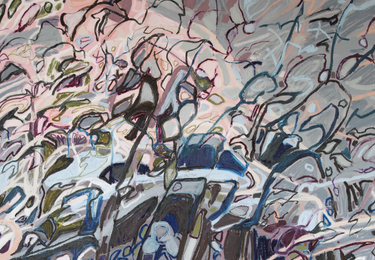
Janaina Tschäpe
FIRE
just sparkles
in the sky
Apr 30 – Jun 25, 2022
Opening
Apr 30, 2 pm–6 pm
Carpintaria
Rua Jardim Botânico 971,
Rio de Janeiro
Directions
Download
We are pleased to announce ‘FIRE just sparkles in the sky‘, Janaina Tschäpe’s solo exhibition at Carpintaria, Rio de Janeiro. The eight new paintings included in the show mark a new direction in the artist’s work, which incorporates the use of the oil stick, expanding her gestural possibilities and intensifying the vigor of her compositions.
There’s a fire that shines in the painting’s sky
By Pollyana Quintella
There is nothing stable here. Floating entanglements run from here to there, overlapping and advancing on top of each other, profaning the surface with stammering sentences that soon dissolve, as a way of attracting the gaze to the orbit of their magnetic field. Perhaps we are looking at fragments of a world committed to refusing unequivocal meanings, a world interested in producing ambivalent whispers between transparency and opacity, noise and muteness.
Janaina Tschäpe’s present exhibition brings to the Brazilian public the results of a recent shift in the artist’s practice – the watercolor pencils and crayons from before have been replaced by oil sticks, adding more malleability and fluidity to the surface, as well as an expansion of colors and gestural possibilities (they allow her to literally ‘draw with oil paint’). There is, however, an invitation to experience the painting as visual stratification. Underneath the fast and expressive lines made with the sticks, there are large casein brushstrokes, which give structure to the painting, creating a watery and suggestive look that is contrasted with the authoritative texture of the oil. Tschäpe brings together different properties in order to build a unique pictorial body that oscillates between the ethereal and the palpable, the volatile and the imperative: whilst the oil flaunts the capacity to give tangibility to the elements it inscribes, casein reveals transparency and the route taken by the gestures, as well as making the color experience more diluted, giving it a more washed aspect (however, this is not about a ‘neutral background’ there to highlight gestures; instead, the background is also an active element). If now and then these large brushstrokes tend to invite the gaze to take a deep plunge, like the appeal of a landscape, the oil traces reinforce the surface’s irremediable planarity. Between the two instances, the gaze is displaced in comings and goings – a movement typical of a work dedicated to giving visibility to the space between ourselves and what we see, that is, to the way the world touches us and how we touch it.
Furthermore, we can see in these entanglements not only the vastness of a landscape made of everything that the eye can see and reinterpret, but also microscopic fragments (like enlarged details), which take us in the opposite direction, to the most intimate core of things, as if by saying: you don’t need to go that far. The comings and goings are not restricted to the eyes that glide between pictorial layers, but encompass the subjective attributions that the painting urges us to conjure. Tschäpe is not just painting the remains of the worlds that she has seen, but, most of all, things that she has re-seen and trans-seen; things she is able to remember, imagine and envision in the space between the hand and the eye. And, as such, she must claim memory and imagination as indissociable instances. We know it is difficult to imagine without delving, more or less intentionally, into past reminiscences. To imagine (that is, to expand the negotiable horizons of the possible) implies the engagement with our own experiences and repertoires. It is also not possible to remember without a dose of fiction. This is why her paintings are fated to constitute an other place, their own space-time. In fact, it is precisely in the other place that her painting exercises take place, as if it was possible to handle and maneuver the horizon in its plasticity. Here, abstraction is not opposed to imagination because its outcome is above all lyrical: it calls into question the allegedly translucent split between objectivity and subjectivity (so dear to the 20th century), not as a way of affirming a romantic and idealized expressivity but to include the subject in the substance of language itself.
In this sense, it is relevant to note how the gestures with the oil sticks produce the sensation that we are in front of a writing full of scribbles and scratches between the symbolic and the mute trace, the imminence of a significant form and pure gestural expression. This is about a constant interaction between the production of recognition (familiarity) and unrecognition (the failure and subversion of the idea of signification itself). As far as it operates between the desire to erect meaning and its own dissolution, this writing-landscape makes us look at the text in its condition of fragile legibility, reminding ourselves that language is also, above all, plasticity and drawing. It is not by chance that the artist, in parallel to her pictorial work, is also dedicated to writing (tracing) brief poems that work as exercises for the elaboration of the sensitive thoughts expressed in her practice. It is a transit from word to gesture, and gesture to word. One of the examples is the title of this exhibition, a sort of haiku that sees painting as the capturing of an elusive event that is about to transform before our eyes. The line that crosses the words seem to doubt their meaning, letting go of the object (fire) and its context (in the sky) in order to emphasize the action (just sparkles), through which the diminutive narrative is also transformed into image. Looking at the provocation made by the title, works such as Waldstille (lunar mystery manifested in the forest’s veins and filaments), A Fire (impetuous flame pointing up) and paisagem para vagalumes [landscape to fireflies] (full of light points that emerge from the darkened surface) are just sparkling to our eyes, sensing the glare of painting.
But even though the group of works share similar concerns, it is important to acknowledge that each one of them suggests different solutions, meaning that their approximation is more a matter of contiguity than similarity. In some cases, the lines are denser, agglomerated and more rhythmic (such as in Gray Pink Mind); in others, they are more dispersed and hollower, closer to scribbles (this is the case of Mars Brown Sparkles). The palette is also considerably diverse, even though there is a multiplication of vibrant tensions between the different chromatic fields, and, in the majority of cases, the color tends to provide an experience of freshness and vivacity. Either celestial, geological or aerial, these are compositions that seek to match atmospheric contexts, independently of their geographical coordinates. They are a way of making the painting explore the limits of its signification, the moment when painting allows itself to deal with its other non-significant elements, such as movements, energies, sensations and abstractions dancing in the confines of consciousness.
Yuko Tsushima says that ‘perhaps memory is nothing but looking at things up to their limit’. Looking at these paintings, we have the feeling that we are accessing the crux of certain experiences, no matter how elusive they are. Ironically, Tschäpe produces, at once, the capturing and the transformation of these fragments of the world. The fire that sparkles in the sky of the painting is the defiance of a gesture that resists the imminent darkness. It goes on and off, up and down… like the pulsation of a living organism.

